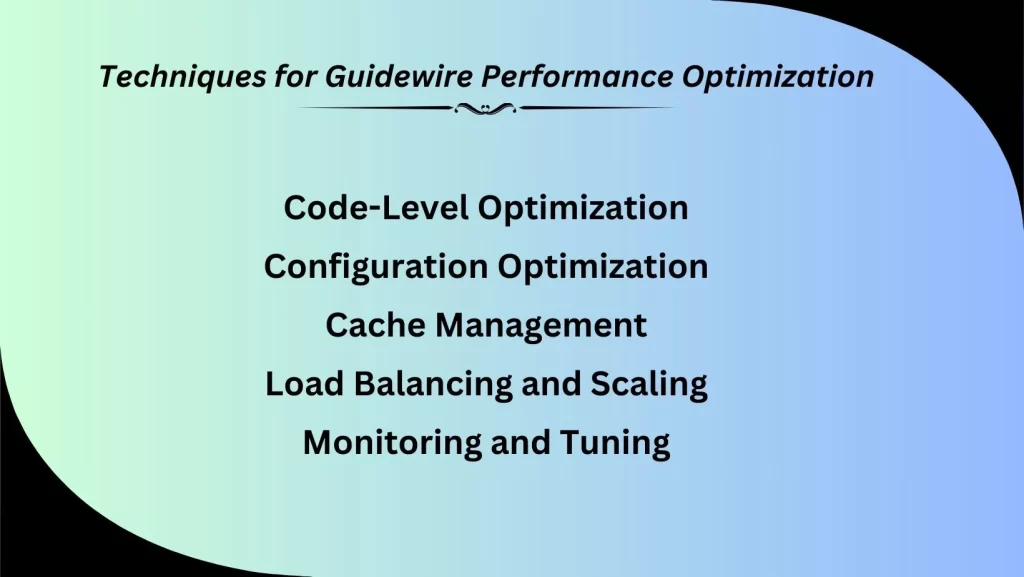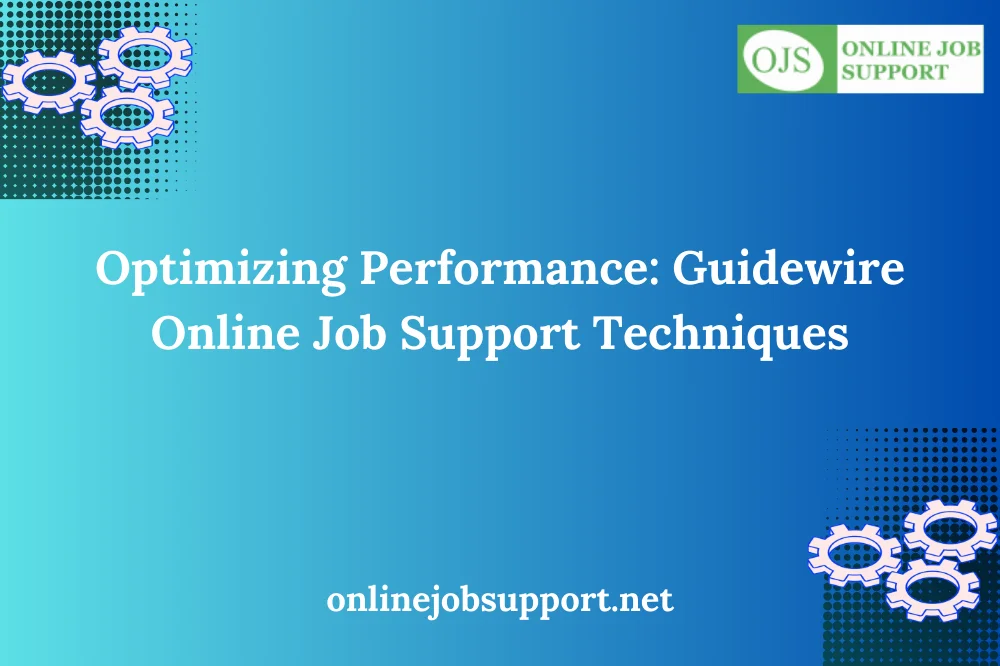I. Introduction
A. Brief evaluate of Guidewire and its significance within the coverage industry
Guidewire is a leading provider of software answers for the coverage industry, imparting various products and services tailored to the wishes of insurers. Its significance lies in its ability to streamline tactics, decorate consumer reviews, and enhance operational efficiency for coverage businesses international.
B. Importance of optimizing overall performance in Guidewire programs
Optimizing overall performance in Guidewire packages is vital for making sure easy and green operations within insurance corporations. High performance allows for faster claim processing, faster coverage issuance, and progressed common user experience for both personnel and customers. It additionally enables reduce fees and increase productiveness, in the end leading to higher enterprise outcomes.
C. Purpose of the blog: Providing powerful online job guide techniques for optimizing Guidewire performance
The purpose of this blog is to offer realistic and effective strategies for supporting and optimizing Guidewire overall performance in online task settings. By sharing hints, strategies, and great practices, we goal to empower professionals inside the insurance enterprise to maximise the performance in their Guidewire applications, thereby enhancing their efficiency and effectiveness in their roles.
II. Understanding Guidewire Performance Optimization
A. Key performance metrics in Guidewire packages
In Guidewire applications, numerous key overall performance metrics are essential for assessing and optimizing system performance. These metrics commonly consist of:
Response Time: The time taken for the machine to reply to user requests, along with loading a page or processing a transaction.
Throughput: The wide variety of transactions or operations that the gadget can cope with within a given time frame.
Resource Utilization: Monitoring the utilization of CPU, memory, disk I/O, and community bandwidth to ensure green useful resource allocation.
Error Rates: Tracking the frequency of mistakes or screw ups encountered all through machine operations, inclusive of timeouts or exceptions.
Scalability: Assessing the machine’s potential to address growing workloads or person demands without extensive degradation in overall performance.
B. Common performance bottlenecks and challenges
Optimizing Guidewire overall performance entails addressing common bottlenecks and demanding situations which could impact system performance. Some of those include:
Database Performance: Slow database queries, inefficient indexing, or database rivalry can extensively affect ordinary device overall performance.
Configuration Issues: Suboptimal configuration settings, such as thread pool sizes or cache settings, can result in overall performance degradation.
Integration Complexity: Performance problems may also arise from complex integrations with external systems, requiring careful management and optimization.
Customization Overhead: Extensive customization of Guidewire packages can introduce complexity and overall performance overhead, requiring cautious optimization.
Network Latency: Poor network connectivity or high community latency can affect the responsiveness of Guidewire packages, mainly in distributed environments.
C. Benefits of optimizing Guidewire performance
Optimizing Guidewire performance offers several advantages for insurance agencies and their stakeholders:
Enhanced User Experience: Improved system responsiveness and faster transaction processing result in a better user enjoy for both employees and customers.
Increased Efficiency: Optimized overall performance reduces processing instances, streamlines workflows, and enhances standard operational performance inside insurance groups.
Cost Savings: By maximizing system performance and resource usage, optimization efforts can help lessen infrastructure costs and operational charges.
Competitive Advantage: High-appearing Guidewire programs permit coverage businesses to stay aggressive by way of handing over advanced service and responsiveness to clients.
Scalability and Growth: Optimized overall performance guarantees that Guidewire applications can scale to accommodate growing workloads and evolving business wishes effectively.
Overall, optimizing Guidewire performance is vital for making sure the easy operation, efficiency, and competitiveness of coverage companies in contemporary dynamic marketplace.
III. Techniques for Guidewire Performance Optimization

A. Code-Level Optimization
Identifying and addressing inefficient code:
- Conducting code evaluations to discover performance bottlenecks and inefficient algorithms.
- Utilizing profiling gear to pinpoint regions of code that eat immoderate sources.
- Refactoring code to optimize algorithms, reduce complexity, and improve performance.
Utilizing best practices for Java development in Guidewire:
- Adhering to Guidewire’s coding requirements and suggestions.
- Employing right exception handling to keep away from pointless overall performance overhead.
- Using efficient facts structures and collections to optimize memory usage.
- Employing multithreading and asynchronous programming in which appropriate to maximise concurrency and responsiveness.
B. Configuration Optimization
Fine-tuning server configurations for optimum performance:
- Adjusting JVM parameters including heap length, garbage collection settings, and thread pools to in shape application necessities.
- Optimizing internet server configurations, consisting of connection limits, request timeouts, and buffer sizes.
- Configuring caching mechanisms for static content and dynamic records to lessen server load and enhance response times.
Adjusting database settings and connection swimming pools:
- Optimizing database indexes, query plans, and storage configurations for green facts retrieval and manipulation.
- Fine-tuning connection pool settings to limit connection overhead and maximize throughput.
- Implementing database caching and question caching techniques to lessen database load and enhance average device overall performance.
C. Cache Management
Leveraging caching mechanisms in Guidewire:
- Utilizing Guidewire’s integrated caching mechanisms, inclusive of entity caches and policy caches, to shop regularly accessed data.
- Configuring cache expiration guidelines and invalidation techniques to make sure information consistency and freshness.
- Implementing distributed caching answers for scalability and resilience in clustered environments.
Strategies for green cache usage:
- Identifying hotspots and excessive-site visitors facts factors for caching to maximise cache hit fees.
- Monitoring cache utilization and overall performance metrics to best-music cache configurations dynamically.
- Implementing cache prefetching and lazy loading strategies to minimize cache misses and enhance typical responsiveness.
D. Load Balancing and Scaling
Implementing effective load balancing techniques:
- Deploying load balancers to distribute incoming site visitors lightly throughout multiple server times.
- Configuring health exams and dynamic routing algorithms to direction requests based on server availability and potential.
- Scaling horizontally through including or putting off server instances dynamically based on workload demands.
Scaling Guidewire applications to address multiplied hundreds:
- Utilizing cloud-based infrastructure and auto-scaling abilties to evolve to fluctuating demand.
- Implementing allotted caching and session replication to hold state consistency across scaled-out instances.
- Monitoring device performance and capacity metrics to proactively regulate scaling techniques in reaction to changing workload patterns.
E. Monitoring and Tuning
Implementing monitoring equipment for overall performance analysis:
- Deploying application performance monitoring (APM) gear to gather actual-time performance metrics and diagnose problems.
- Setting up indicators and notifications for unusual overall performance styles or threshold violations.
- Analyzing overall performance statistics to discover optimization opportunities and prioritize tuning efforts.
Techniques for real-time performance tuning:
- Dynamically adjusting configuration parameters and aid allocations based totally on workload traits and overall performance metrics.
- Implementing runtime instrumentation and profiling to become aware of and clear up overall performance bottlenecks on the fly.
- Performing periodic overall performance exams and benchmarking to validate tuning efforts and make certain sustained upgrades over the years.
IV. Best Practices for Online Job Support in Guidewire Performance Optimization
A. Understanding client necessities and demanding situations:
- Conduct thorough discussions with customers to apprehend their unique overall performance optimization desires and challenges within Guidewire applications.
- Gather specified data approximately the environment, workload patterns, and performance metrics to tailor assist techniques hence.
- Collaborate with clients to define clear targets and success criteria for overall performance optimization efforts.
B. Effective communication and collaboration with the development crew:
- Establish open traces of conversation with the development crew to change insights, percentage findings, and coordinate optimization efforts.
- Foster a collaborative environment in which group participants can contribute ideas, endorse answers, and address issues together.
- Provide everyday updates to stakeholders on development, demanding situations, and proposed answers to hold transparency and alignment.
C. Providing well timed troubleshooting and determination help:
- Offer prompt assistance to cope with performance problems and troubleshoot technical demanding situations as they rise up.
- Utilize far flung get admission to gear and screen sharing to facilitate actual-time troubleshooting and debugging classes.
- Document troubleshooting steps and resolutions for future reference and know-how sharing.
D. Documentation and understanding sharing for lengthy-term performance improvement:
Document nice practices, optimization strategies, and instructions found out in the course of overall performance optimization engagements.
Create comprehensive guides, tutorials, and documentation repositories to disseminate knowledge and empower stakeholders to address performance troubles independently.
Encourage ongoing learning and professional development through education classes, workshops, and expertise-sharing forums.
V. Case Studies and Examples
A. Real-world examples of Guidewire overall performance optimization challenges:
- Highlight specific overall performance demanding situations encountered in Guidewire packages, along with sluggish reaction instances, excessive useful resource usage, or scalability troubles.
- Showcase numerous eventualities across specific modules or functionalities inside Guidewire, illustrating commonplace overall performance bottlenecks and their effect on enterprise operations.
B. Solutions implemented and results done:
- Describe the strategies, strategies, and optimizations applied to cope with overall performance challenges in each case take a look at.
- Quantify the performance enhancements achieved, consisting of reduced response times, improved throughput, or optimized resource usage.
- Provide before-and-after comparisons to demonstrate the tangible benefits of overall performance optimization efforts.
C. Lessons learned and pleasant practices derived from case studies:
- Reflect on the insights won from each case take a look at, consisting of key learnings, a hit tactics, and pitfalls to avoid.
- Extract overarching first-class practices and optimization principles applicable across distinctive Guidewire overall performance optimization scenarios.
- Offer realistic hints and tips for making use of classes found out from case research to future performance optimization initiatives.
VI. Future Trends in Guidewire Performance Optimization
A. Emerging technology and methodologies for enhancing Guidewire performance:
Explore upcoming technologies, tools, and methodologies poised to revolutionize Guidewire performance optimization, which includes system getting to know-based anomaly detection, containerization, or serverless architectures.
Discuss revolutionary strategies for leveraging cloud computing, side computing, and microservices to improve scalability, agility, and resilience in Guidewire packages.
B. Predictions for the future of Guidewire optimization:
Speculate at the evolving landscape of Guidewire optimization, including potential challenges, possibilities, and areas for innovation.
Forecast trends in performance tracking, automation, and predictive analytics that might shape the future of Guidewire optimization practices.
C. Recommendations for staying updated and adapting to new developments:
Advocate for continuous mastering and professional improvement to live abreast of evolving technologies, methodologies, and first-class practices in Guidewire performance optimization.
Encourage engagement with enterprise boards, meetings, and online groups to exchange ideas, percentage stories, and live knowledgeable approximately the contemporary developments and developments.
Guidewire online job support offers expert assistance in optimizing Guidewire performance, addressing client challenges promptly, and implementing effective solutions. Our support team ensures seamless communication and collaboration with the development team, timely troubleshooting, and comprehensive documentation for long-term performance improvement. Experience enhanced Guidewire performance with our tailored solutions and stay updated on emerging trends for continuous optimization.
VII. Conclusion
A. Recap of key points discussed:
Summarize the important thing insights, strategies, and quality practices provided in the weblog, emphasizing their significance in optimizing Guidewire performance.
Reinforce the importance of understanding purchaser requirements, powerful communication, timely troubleshooting, and documentation for successful process aid in Guidewire performance optimization.
B. Importance of continuous performance optimization in Guidewire programs:
Stress the continued nature of performance optimization in Guidewire programs, driven through evolving business necessities, era improvements, and changing person expectations.
Highlight the aggressive benefit gained via corporations that prioritize and invest in continuous performance optimization to supply excellent consumer reports and operational efficiency.
C. Encouragement for readers to put into effect the outlined strategies for advanced performance in their Guidewire projects:
Inspire readers to apply the techniques, strategies, and fine practices mentioned in the weblog to their very own Guidewire initiatives to drive measurable overall performance improvements.
Encourage collaboration, information sharing, and a proactive technique to performance optimization to unlock the overall capacity of Guidewire applications and pressure enterprise fulfillment.

